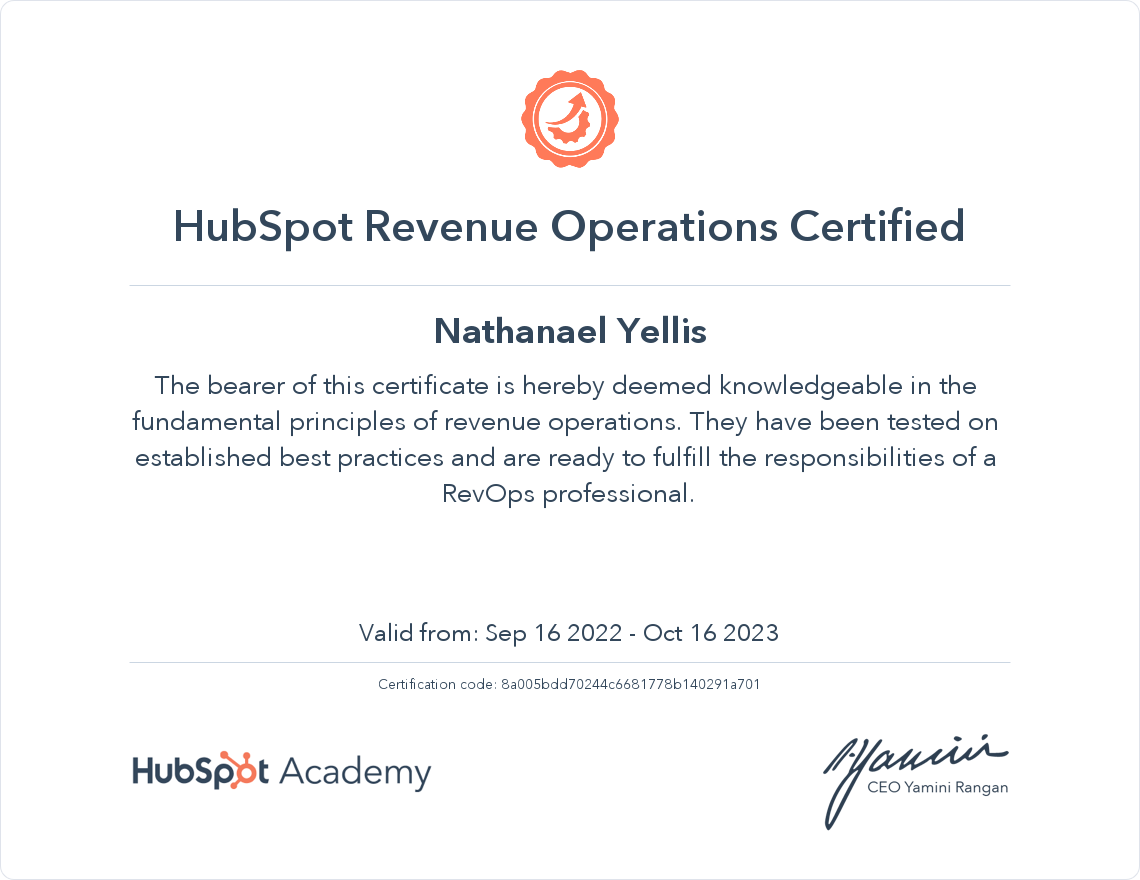HubSpot's Revenue Operations Certification: Lessons Learned

After taking a few years off, I got back to badge-earning by finishing HubSpot Academy's Revenue Operations certification on September 16th. This course was almost as wide-ranging as my HubSpot consulting role: it covered everything from strong sales process definition to the Lean SixSigma definition of waste to accounting basics to hiring. Any role in operations, whether you're a team of one or dozens, is similarly wide-ranging.
More than a few of the lessons resonated with me. I work with marketing, sales, and service teams: their commonalities are my biggest learning on the job. The strongest teams tend to get a few core things right and the struggling teams seem to have trouble in the same areas. Below are my highlights of where the certification overlaps with what I see in my work.
Overview: Revenue Operations and Strategy
- What is revenue operations? It's getting all customer-facing teams (marketers, salespeople, and service or support) aligned by centralizing their operations. This may be an organizational structure: to rollup those teams to a single executive. The purpose to aligning these teams is to make the entire go-to-market staff focus on serving the people the business serves. It's how an organization becomes (and stays) customer-first.
- Scale vs. growth: a business is one of the few organisms always expecting to grow (among others in this category: viruses). The idea of scaling is becoming more efficient and more profitable, not just having more revenue. HubSpot phrases this as "grow better." Scale is growing revenue without proportionally requiring more time and more money.
- Flywheel Strategy: if all customer-facing efforts can be described as a flywheel (where momentum in one area makes the next that much better), then the go-to-market strategy must unite as well. The RevOps insight here is to pull incentives back: pay marketing on closed sales, pay sales on delighted customers, and pay support on upsell/renewal/referral.
- Fight Friction Intelligently: a major input for RevOps teams will be frustrations from customers or from staff, but friction isn't always bad. Friction needs to be worth it. You should know why something is hard. And if there's no reason: make it easier.
Most Important Process for Revenue: Sales
The certification rightly focused on the sales process: it's the thing most directly responsible for revenue and it's the direct recipient of marketing's success and contributor to service's success. You sorta wished marketing ops and services ops got a bit more of their due in the certification, but on the other hand, the more folks in those roles learn from the sales ops approach, the better.
- Sales Process Starts with the Buying Journey: good process design knows who the process should serve. The seller, the contract manager, and the accountants all play a part, but the person who is buying is most important. The seller's focus must be supporting the buyer's "jobs to be done" at each stage (aware/problem, consider/category, decide/solve).
- Good Deal Stages Have a Goal: in HubSpot lingo, the sales process steps are the stages in our deal object. Sales process steps should include exit criteria that both sides (the buyer and seller) would agree on and cannot get to "sold" without. Skippable steps aren't good deal stages; single-sided deal stages aren't really a part of the buyer's process.
- Where Process Joins Methodology: the buying journey is what they need, the deal stages are what we do, but the sales methodology is how we work with the buyers through their journey. Methodology is the content framework that belongs in a sales playbook. We should teach sales reps to do their job not in a CRM system-only, but rather in what to know, what to do, and what to say.
Data & Systems for Revenue
- Measure in Revenue: for revenue operations to truly unify the go-to-market, every vital metrics needs to be translated back to revenue.
- Enforce Service Level Agreements (SLAs): most companies create inter-department SLAs, but few review and enforce them. This is done with a "judicial branch" of cross-functional leadership, a reason to put an executive over sales, marketing, and service.
- Align on Metrics: the whole go-to-market organization must agree on how business processes are measured and what the source of truth is. Handoffs can exist, but definitions must be shared to work.
- Data First, Systems Second: too many CRM+ operations start with software rather than the process it's intended to support. Tech stack choices must come after data processes and governance are decided. Map the whole stack against the lead to customer lifecycle. What sits where? Why is each piece separately needed?
- Systems: you can never add simplicity, but you can remove complexity.
Ongoing Revenue Operations
- Buyers are always experience-first, thus companies and their internal teams need to align on customer experience, not functional silos. That's why a good strategy is built on customer-in, not function-out.
- Make sure ongoing meetings, team structure, and metrics put customer value at the top. This may seem hokey (customer interviews in org. meetings) or micro-managing (executives looking at NPS surveys) but these practices are what drive people to focus on what matters.
- Beware of hiring people with process, data, or system assumptions: operations decisions need to be contextual. Don't fall for the "in my last role we..." argument unless it's explained.
- Communicating for the business: RevOps teams need to know enough about accounting to position their process, data, and system recommendations to company leaders. Operational changes are only good if they save money or earn money.
- Iterating Strategy: use both new projects and stop doing lists to make sure you're solving for the next, not the past or distant future.
- Alignment Eats Strategy: multi-year strategies need to become quarterly/monthly goals and even daily/weekly priority setting. Rigor in cadence is the only way big things get accomplished in the long-run.
